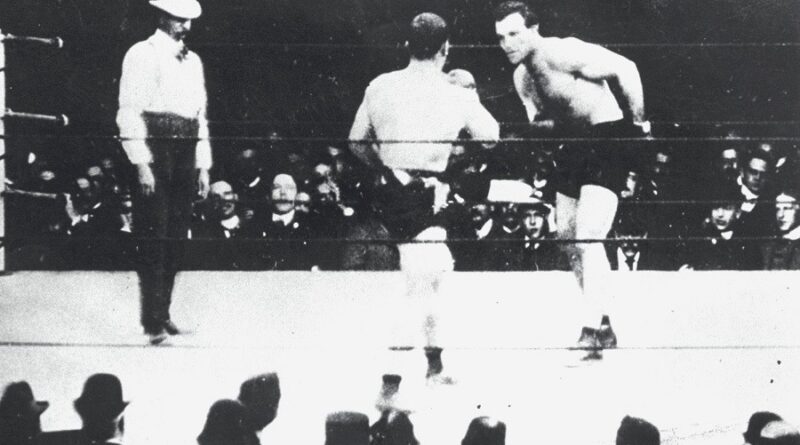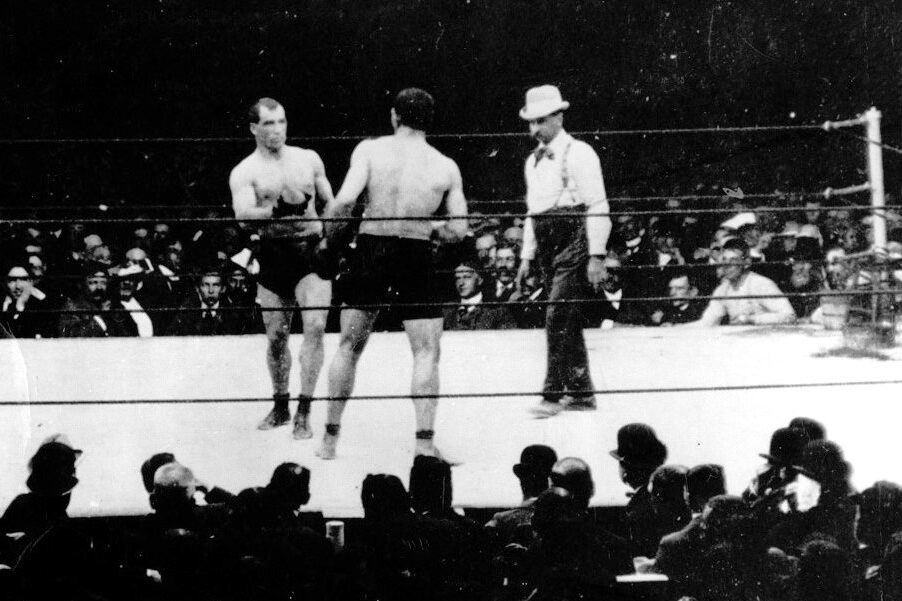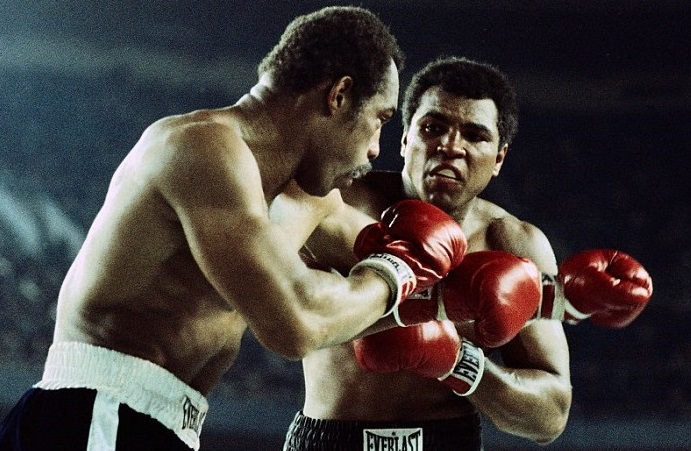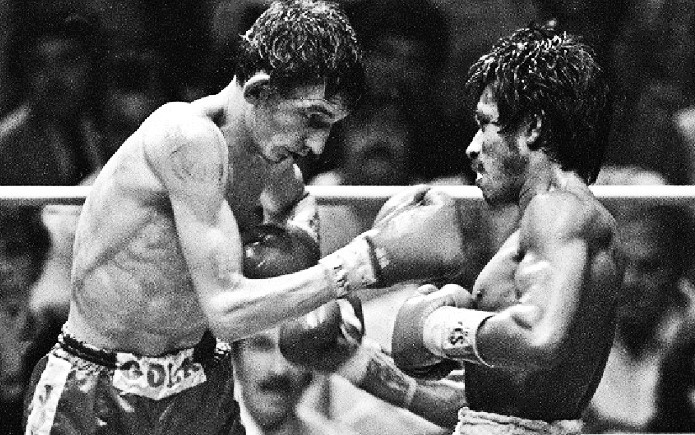Nov. 3, 1899: Jeffries vs Sharkey II
James J. Jeffries, a former boilermaker from Los Angeles, California, was the hulking, square-jawed heavyweight champion of the world, the third to win the title with gloves on. His predecessors were the bare-knuckle icon John L. Sullivan, the crafty and scientific James J. Corbett, and the hard-hitting Bob Fitzsimmons, the man from whom he won the crown via knockout on June 9th, 1899, at Coney Island. Known for his ability to deliver and endure punishment, Jeffries was a muscular slugger who fought out of a unique crouch, his left hand extended out before him.
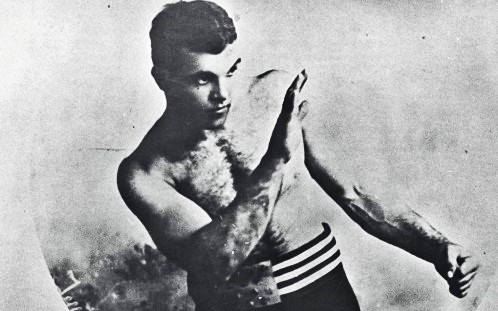
Less than five months after securing the most prized title in sports, Jeffries was back at Coney Island to make his first defense against Ireland’s Tom Sharkey. The tattooed “Sailor Tom” had learned to box while serving in the U.S. Navy. A stockier version of the much larger champion, Sharkey stood less than 5’9″ tall (Jeffries was almost 6’3″), but he was a rugged warrior. He had shared a ring with both Corbett and Fitzsimmons and took Jeffries through twenty hard-fought rounds in San Francisco in 1898, losing by decision. After “Jeff,” as Jeffries’s fans called him, won the championship, a rematch was only logical.
The second Jeffries vs Sharkey battle was scheduled for twenty-five rounds and would supersede even the original for brutality. four hundred newly installed arc lights hung too low above the ring to illuminate the action for the primitive movie camera that would be rolling for posterity. They were so low, Jeffries later said that he could reach up and touch them. An electrician insisted they were the most powerful assemblage of lights yet assembled in one place by man, equaling the power of eighty thousand candles. When they were turned on, they temporarily blinded the audience. The writer for The Brooklyn Daily Eagle felt the temperature at ringside was possibly over one hundred degrees. For the fighters, the result was scalding heat that literally blistered their skin over the course of the match.
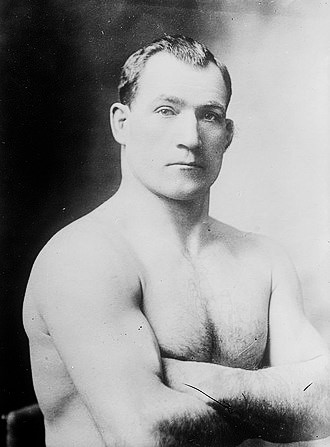
Challenger Sharkey was the aggressor from the start, swinging away at the jabbing champion, who landed the more precise blows in the early going. Enjoying a six-inch height advantage and a reach advantage of the same amount, the normally slugging Jeffries showed more boxing ability than ever before in keeping his opponent at a distance and using head movement to avoid incoming blows. He had been training of late with the skilled middleweight champion Tommy Ryan. Sharkey’s weapon of choice was the left hook, and he connected several of these to Jeffries’s head in the opening frame. When the smaller man got inside, Jeffries leaned all of his 210 pounds upon the challenger’s neck and back. He outweighed Sharkey by 27 pounds.
In round two, Jeffries scored a knockdown near a corner. The Irish fighter made it to his feet and rushed right back in, only to hit the deck a second time. But he made it up yet again and, showing great resilience, landed a right to the champion’s ribs that was “enough to knock a hole in a stone wall.” But it was also during this round that Jeffries’ left arm gave out, the result of a previous injury. For the rest of the fight, he would have to rely almost exclusively on his right.
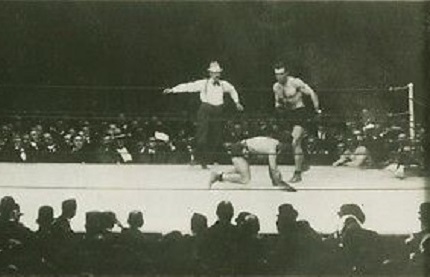
Rounds three through seven bore witness to the most thrilling ring action since the bare-knuckle age. Fans would afterward continuously argue over who won these rounds, with Sharkey as the unrelenting aggressor and the one-armed Jeffries laying back and landing the more telling single shots. A succession of hard rights from Jeff in the eighth round had Sharkey nearly out. A bad cut over his left eye multiplied Sharkey’s troubles in the tenth and made a scarlet target for Jeffries through the rest of the fight.
Both combatants showed signs of fatigue by the middle rounds, but Jeffries caught a second wind in the later stages and switched his punishment to Sharkey’s ribs, resolving to finish the fight and get out from underneath the punishing lights. With a single blow (sources differ as to the round in which it occurred), he cracked one of Sharkey’s ribs. “I felt the rib go,” Sharkey said later. “It jumped in, and then I thought it would jump out of my skin.” Amazingly, the challenger refused to relent. As the fighters mauled away at center ring, a headbutt opened a gash on the champion’s forehead; another chipped a tooth. Sharkey’s right ear had swollen to grotesque proportions; “a big wet sponge,” was how Jeffries later described it. Both fighters were bloodied, blistered, and bruised. The heat under the lights was so intense that multiple people ringside lost consciousness. Jeffries, the ex-boilermaker, later compared it to standing before a blast furnace for more than an hour. Yet both warriors fought on.
In round twenty-four, Sharkey repeatedly uncorked his left hook in a desperate bid to secure a knockout over the bigger man. But he left himself wide open, and the champ countered with punishing rights to the jaw that repeatedly staggered the challenger, forcing him to hold to stay on his feet. To start the final frame, Sharkey charged across the ring like a horned ram. He walked through stiff jabs and snapping uppercuts to unleash his own furious assault on Jeffries’s skull, but he left his damaged ribs exposed and Jeffries sent home right-hand blows to Sharkey’s side. Decades later, writer Alexander Johnston, who was at the fight, remembered the report of those punches echoing through the arena. Another well-timed uppercut to Sharkey’s jaw nearly finished him, but “Sailor Tom” held on long enough to stay on his feet. Both were exhausted and the fight devolved into pure caveman-like brawling, Jeffries clearly getting the better of it.
As the final bell approached, Jeffries shoved Sharkey to the floor. Turning “a complete somersault” in his fall, Sharkey clutched Jeffries’s left glove and pulled it off. Sharkey then stood up and, as referee George Siler was lacing up the champion’s glove, lunged around the ref to attack. Though there are different versions of the story, many contend that Jeffries retaliated with a powerful bare-handed blow. Siler pushed Sharkey away, and the bell rang. Ignoring it, Sharkey lashed out with a right hand that struck Jeffries on the shoulder before he could be dragged away.
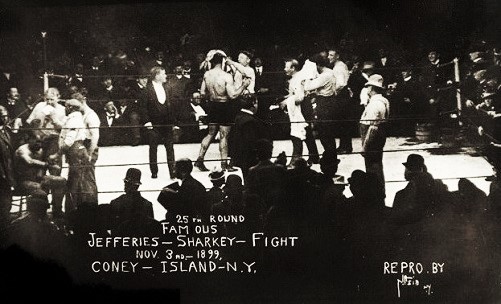
Siler awarded the fight to Jeffries, and the crowd boisterously agreed, though Johnston later reported that Sharkey had his loyalists, who favored the challenger’s unrelenting aggression. The fight had lasted an hour and forty minutes under the torturous blaze of the electric lights. Afterward, both fighters admitted that the heat fatigued and dehydrated them. Jeffries claimed to have lost twenty pounds in his effort to save his title and he would never again fight underneath such lights, lucrative film proceeds be damned.

